Early Reading

Phonics at Brampton Primary School
At Brampton Primary School we aim for all our children to become fluent, confident readers who are passionate about reading.
Children who read regularly, or are read to, have the opportunity to open the doors to so many different worlds! More importantly, reading will give your child the tools to become independent life-long learners. We can achieve this together through:
- Accessing Read Write Inc, a programme to help to your child read at school
- Encouraging children to develop a love of books by reading to them daily, at home and at school
- Giving children access to a wide range of books at school and at home
At Brampton Primary School we use Read Write Inc Phonics (RWI) to give your child the best possible start with their reading and writing.
We have put together a guide to explain how the RWI programme works, together with some useful links.
‘Every child has the right to read because without being able to read children have absolutely no access into their education’ (Ruth Miskin, Creator of RWI).
Reading opens the door to learning. A child who reads widely will become a good reader. A good reader will be able to read more challenging material. A child who reads challenging material is a child who will learn quickly and effectively. The more a child learns, the more he/she will want to find out. Using RWI, the children learn to read effortlessly so that they can put all their energy into comprehending what they read. It allows children to spell effortlessly so that they can concentrate on composing what they write.
Year 1 and above
Children follow the same format as Reception but will work on complex sounds. Daily sessions of RWI phonics last for 25 minutes. We want children to become confident and fluent readers, so accuracy in reading is vital.
Mrs Shovlin is our designated Read Write Inc lead. If you have any questions about RWI, contact the school and ask to speak to her. Please take the time to read through this page, as it will provide invaluable information on how you can help and support your child in reading.
Read Write Inc (RWI) is a phonics programme which helps all children learn to read fluently and at speed so they can focus on developing their skills in comprehension, vocabulary and spelling. At Brampton Primary we start the programme in Nursery. The programme traditionally runs until children reach the age of 7. We assess the children throughout their time on the programme. There are times when children are still on the programme after the age of 7. These children will have really targeted interventions.

Parent video: What is Read Write Inc Phonics
Uploaded by Ruth Miskin Training on 2019-09-12.
How will RWI be taught?
All children are assessed regularly by our RWI lead teachers, so they work with children at the same level. This allows complete participation in lessons.
Nursery
Children are introduced to the letter formation rhymes, almost immediately, when joining the Nursery. Children are exposed to Fred Talk with the teaching staff playing Fred Games with the children. Your child is taught to hear sounds and blend them together in sequence, to make a word. In the Summer term, children due to move up to Reception, in the Autumn term, will be introduced to the initial sounds. The children will take part in daily five minute sessions.
Reception
In Reception, all children will learn how to ‘read’ the sounds in words and how those sounds can be written down. Those who are ready, will begin to read and write simple words within books and begin to take books home, linked to their reading level ability. Children will take part in fun RWI lessons between 30-40 minutes a day. This lesson involves the teaching of a new sound, decoding, blending and writing words and eventually moving on to reading short story books.
Reading
The children:
- learn 44 sounds and the corresponding letters/letter groups using simple picture prompts – see below
- learn to read words using Fred talk and sound blending
- read from a range of storybooks and non-fictions books matched to their phonic knowledge
- work well with partners
- develop comprehension skills in stories by answering ‘Find It’ and ‘Prove It’ discussion questions
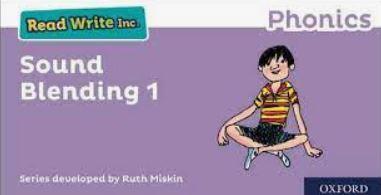
Writing
The children:
- learn to write and form the letters/letter groups which represent the 44 sounds with the help of fun phrases
- learn to write words by using Fred Talk
- learn to build sentences by practising sentences out loud before they write
Talking
The children work in pairs so that they:
- answer every question
- practise every activity with their partner
- take turns in talking and reading to each other
- develop ambitious vocabulary

Year 1 and above
Children follow the same format as Reception but will work on complex sounds. Daily sessions of RWI phonics last for 30 minutes. We want children to become confident and fluent readers, so accuracy in reading is vital.
What are the five key principles that underpin the teaching in all Read Write Inc. sessions?
- Purpose – know the purpose of every activity and share it with the children, so they know the one thing they should be thinking about
- Participation – ensure every child participates throughout the lesson. Partnership work is fundamental to learning
- Praise – ensure children are praised for effort and learning, not ability
- Pace – teach at an effective pace and devote every moment to teaching and learning
- Passion – be passionate about teaching so children can be engaged emotionally
What does a Read Write Inc lesson look like?
Each lesson has the same structure, so that children focus on the new learning, rather than worrying about what is going to happen next. Children are grouped according to their ability, so that they only tackle work that is achievable, making it more enjoyable and allowing learning and confidence to flourish side by side.

Speed Sounds and Read Write Inc. Stages
If your child is learning to read at school with Read Write Inc. Phonics, they will be at one of the following stages:
Learning Set 1 Speed Sounds:

Check if your children can read these sounds. Make sure they say sounds like ‘sss’, NOT letter names like ‘es’. Watch the Phonics Pure Sounds video below to help you.
Learning to Blend with Set 1 Speed Sounds:
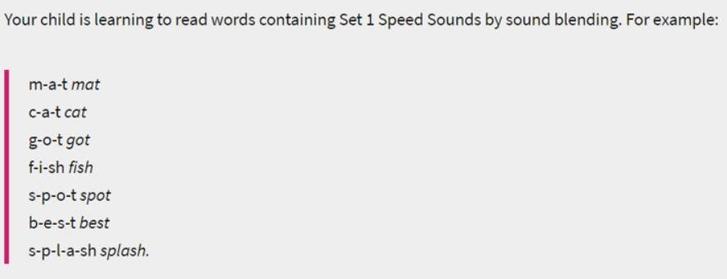
Watch this Sound Blending Phonics video to help you teach sound blending at home.
Learning Set 2 Speed Sounds:

Nonsense words (Alien words)
As well as learning to read and blend real words children will have plenty of opportunities to apply their sound recognition skills on reading ‘Nonsense words’. These are made up of the sounds the children are learning e.g. d-u-t (dut), d-oi-n (doin), h-e-sh (hesh).
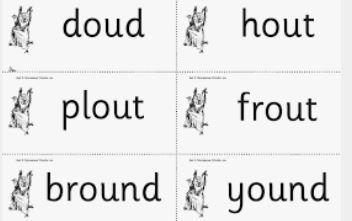
Learning Set 3 Speed Sounds:

Reading the Storybooks
Children will be introduced to ‘Ditty books’ when they successfully begin to read single words. The short vowels should be kept short and sharp:
Children use sound-blending (Fred Talk) to read short ditties. They will bring these home once they have read and discussed the book in class. Children will be challenged to use their developing phonic knowledge, to write short sentences.
Within all the books, children will have red and green words to learn to help them to become speedy readers. Red words are words that are not easily decodable and challenge words to extend children’s vocabulary. Green words are linked to the sounds they have been learning and are easily decodable. Dots and dashes represent the sound each letter makes.
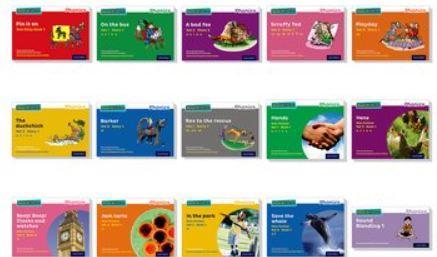
During reading sessions, children will read their books until they are showing fluency and confidence, this is to ensure that children become overly familiar with the text and become fluent and speedy readers- this is all part of the reading process! At each new reading stage, they will have plenty of opportunities to practise using their developing comprehension skills.
Spelling
Spelling will only start in Reception when children are ready to write and form their letters. Children will use ‘Fred Fingers’ to sound out a word first, before they write it down. Children learn how to spell rather than just get tested. Furthermore, this way of teaching spellings allows children to use ‘Fred Fingers’ whenever they get stuck with spelling a word. Children pinch each sound on fingers before writing the word.

Dots and dashes represent the sound each letter makes.
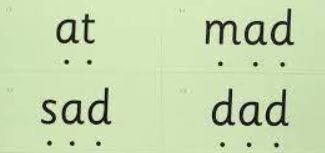
Watch this video clip of how we teach using ‘Fred Fingers’
How to help your child with Phonics!
- Read a variety of books (fiction, non-fiction, rhymes etc).
- Discuss the different features of various books.
- Talk about the books and other reading materials that you have shared.
- Explain the meaning of new words.
Don't forget you don't have to read just books - subtitles alongside TV programmes, shopping lists, road signs, web pages, magazines, newspapers etc. are useful ways to practise reading.
- Supporting reading at nursery (Age 3-4)
- Starting to read (Ages 4-5)
- Building on reading skills (Ages 5-6)
- Developing confidence as a reader (Ages 6-7)
- Building independence (Ages 7-9)
- Understanding Phonics
- How to say the sounds
- Why read to your child?
- 10 things to think about when you read to your child
- Sound blending
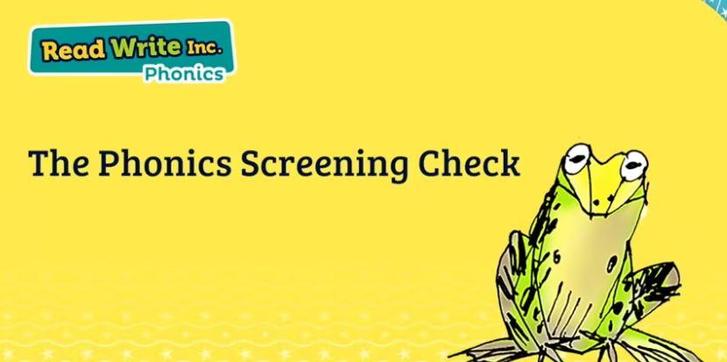
The Phonics Screening Check is a test for children in Year 1. Children take it during June in a one-to-one setting with a teacher. This is usually their class teacher, but it could also be the headteacher or another teacher who knows the child well.
Whilst children learn phonics to help them with both word reading and spelling, the Phonics Screening Check only tests their skills at word reading. This is sometimes called decoding.
During the Phonics Screening Check, children are asked to read (decode) 40 words. Most of these words are real words but some are pseudo-words. Pseudo-words are included to ensure that children are using their decoding skills and not just relying on their memory of words they’ve read before. Because some children may misread these pseudo-words based on their similarity to words in their existing vocabulary, each pseudo-word is clearly identified with an image of an alien. Most teachers and children, therefore, refer to pseudo-words as alien words.
The test itself is divided into two sections. Section 1 is the easier part. In this section, children are asked to recognise simple word structures and Grapheme Phoneme Correspondences (GPCs) from the earlier phases of the phonics curriculum. In 2019, real words included in Section 1 were words like ‘shop’, ‘peel’ and ‘yell’.
Section 2 is the trickier part of the test. Here, children need to recognise GPCs from the later stages of the phonics curriculum. They also encounter graphemes that correspond to more than one phoneme (e.g. the grapheme ‘ea’ represents different phonemes in the words bread and bead.)
There is no time limit for the Phonics Screening Check, but it usually takes less than 10 minutes. Many schools use practice tests so children are accustomed to working one-to-one and reading unfamiliar words. Equally, many schools do not, as the daily phonics lessons in Year 1 already include reading both words and pseudo-words. Whichever approach is taken, most children reach the expected standard. If a child doesn’t meet the expected standard, school will work with them to ensure they receive the phonics teaching and support they need. The child will then retake the Phonics Screening Check the following year.
